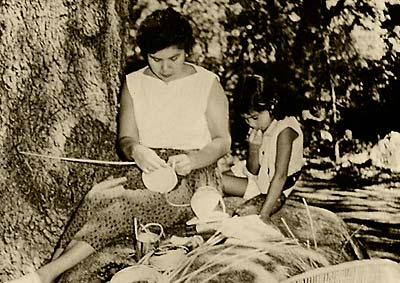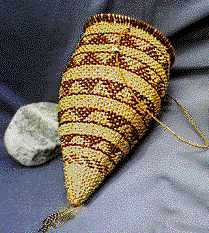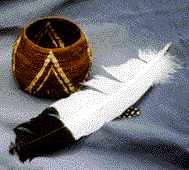|

|

|
NEWS SEARCH
|
|
|
|

|

Behind
the Yosemite Museum in the summer of 1960, Julia
Parker began demonstrating the art of basket weaving
to her daughter, Lucy. On June 2, the duo will demonstrate
for the public as part of "Family Day" at the UC
Berkeley Phoebe Hearst Museum of Anthropology. |
Mother-daughter
interpreters demonstrate California Indian culture at
Hearst Museum's "Family Day"
28 May 2002
By
Kathleen Maclay, Media Relations
Berkeley
- Years ago, Julia Parker taught her daughter, Lucy,
about the art of Native American basket weaving and
other cultural practices. Today, the two are teaching
the ways of their ancestors to Lucy's own daughter,
and introducing them, in turn, to Lucy's six-year-old
granddaughter.
Sharing Indian culture and history with the next generation
is a labor of love for Julia and Lucy Parker. So, they're
happy to participate on Sunday, June 2, in "Family Day"
at the University of California, Berkeley's Hearst Museum
of Anthropology.
During the program, the pair will tell Indian stories and
play primarily Miwok games while airing "gaming" recordings
foraged from the museum's sound recording archives. The
Parkers also will demonstrate the art of basket weaving
and display handmade, miniature dolls and toys.
 |

Julia
Parker also made this 10-by-5-inch burden basket that
is worn at the waist and used for collecting willow
or redbud twigs. Its foundation is willow and has a
background of sedge roots, all coated with soaproot
juice for protection. Photo courtesy of CaliforniaBaskets.com
|
Julia Parker, a noted basket weaver and, for about 40 years,
a nationally-known cultural interpreter with the Indian
Cultural Program at Yosemite National Park, will be joined
by her daughter, Lucy, a traditional artist known for crafting
baskets, jewelry and games.
Julia Parker is a Kashaya Pomo who primarily practices
her husband's family traditions - Yosemite Miwok, Miwok
and Pauite - and weaves Pomo style. She also teaches honoring
songs that celebrate people and nature. Lucy Parker, a descendant
of the Yosemite Indians, is Miwok, Paiute and Pomo and practices
those traditions. She was brought up as a youngster in Yosemite
in a traditional cradle basket.
Mother and daughter are devoted to preserving their culture
and are especially devoted to teaching children. "They're
the future teachers of Indian basket weaving," said Julia
Parker.
The 1:30-3:30 p.m. "Family Day" event is part of the Hearst
Museum's "Regenerations" program, established seven years
ago to provide a stronger public presence for contemporary
California Indian artists. That is accomplished through
a fellowship or residency at the museum, exhibition of the
artists' work or co-curation of museum collections, a lecture,
demonstration or performance, as well as through the purchase
by the museum of representative works of the artists. A
City of Berkeley Civic Arts grant helps fund the program.
Collection of 9,000 California Indian baskets
The first entry in the catalogue of the Hearst Museum's
California collections is a cradle basket acquired in 1901
under the auspices of Phoebe Apperson Hearst, the museum's
founder. Between 1901 and 1996, the museum gathered a research
collection of approximately 9,000 California Indian baskets,
with specimens from every tribe in California, and examples
representing every technique used in basket weaving.
Scholars who collected for the museum, studied the collections
and published their findings in the first half of this century
include Alfred L. Kroeber, Samuel A. Barrett and other noted
anthropologists. Barrett focused on the Pomo, and as he
collected baskets and other artifacts, he carefully documented
maker names, locations, materials and techniques. Barrett
also collected raw materials from which baskets were made,
along with information concerning where and when, or from
whom, the maker collected those materials. His sound recordings
and films of the Pomo also are part of the museum collection.

Julia Parker made this Pomo-tradition gift basket with
a flame pattern woven with dark red twigs that have
been stripped in the winter to achieve the darkest of
reds. Redbud twigs were used to color the entire basket,
measuring five inches in diameter and standing 3.75
inches high. Photo courtesy of CaliforniaBaskets.com
|

|
Julia Parker said the museum collection is an invaluable
tool for telling the story of Indian history and culture
in California. "We're very grateful for the early collectors,"
she said.
"The traditions of our people will go on as long as people
are aware of them," said Lucy Parker. "It is so important
for my mom and I to share the traditions and, fortunately,
our people left a lot for us to follow. The value of the
Hearst collection is so wonderful because we can go in and
study the baskets and so many other items."
In addition to their "Family Day" demonstrations, the Parkers
will spend several days studying various Indian materials
in the Hearst collection.
Julia Parker also will participate in the "Breath of Life"
workshop on California Indian language restoration. She
said she speaks Pauite, Miwok, Mono and Navajo, but not
fluently. That June 3-7 program is co-hosted by the Hearst
Museum, Survey of California and Other Indian Languages,
and Advocates for Indigenous California Language Survival.
Meanwhile, the Parkers also are consulting with the museum
on a teaching kit about Indian games to be used chiefly
by fourth grade teachers in state-mandated California history
lessons. Some games made by Lucy Parker have been donated
to the Hearst Museum and will be on display.
A kit recently developed by the museum that features California
Indian food will be available at the museum for viewing
and will be online in the fall. Another kit is planned that
will focus on Ishi, a famous California Indian whose native
crafts are in the museum's collections.
An exhibit in the museum's new Native California Cultures
Gallery includes displays of Indian games from the Hearst
collections, as well as food-related objects from California's
many tribes.
"Family Day" is free with admission to the museum, which
is $2 for adults, $1 for seniors and 50 cents for youths
16 and younger. Museum members and UC faculty, staff and
students are admitted free. Admission is free to all on
Thursdays.
The museum is located in Kroeber Hall near the intersection
of College Avenue and Bancroft Way. The museum phone number
is (510) 643-7648.
###
|

|